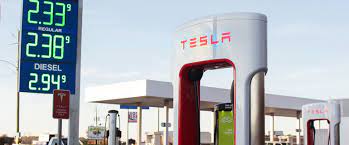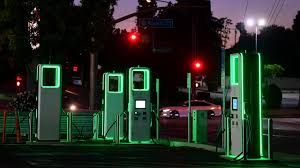Gas stations feeling the heat as electric vehicles become more popular
A new study has shown that electric vehicles could bury gas stations as early as 2030. The study, conducted by the University of Michigan, looked at the total cost of ownership for both electric and gas vehicles. They found that electric vehicles are cheaper to operate and maintain than gas vehicles, even when taking into account the higher upfront cost of electric vehicles. This difference in cost is expected to increase in the coming years as battery technology continues to improve. Tesla Model 3 demand continues to surge Tesla is seeing a massive amount of demand for its Model 3 vehicle. Demand has been so strong that it has caused backlogs of over a year in some cases. To help alleviate the wait time, Tesla is expanding its retail and service presence. The carmaker recently announced that it is expanding the number of stores and service centres by over 30% this year. Tesla is also lowering its service costs for Model 3 owners, with basic maintenance now costing just $29 for four years or 50,000 miles.
The rise of electric vehicles 
As electric vehicles become more popular, gas stations are struggling to keep up. Many are forced to close down, leaving drivers without a place to fill up. This trend is likely to continue as electric vehicles become more prevalent. With no need for gas, these vehicles will make it easier for drivers to go green. Gas stations may soon be a thing of the past, replaced by charging stations for electric vehicles. This shift could help reduce our reliance on fossil fuels and lead to a cleaner future. A few years ago, it seemed like electric vehicles were not ready for the mainstream market. However, with recent advancements in battery technology, electric vehicles are becoming more popular.In fact, the electric vehicle industry is growing at a faster rate than hybrid vehicles.
The low cost of operating an electric vehicle and its ability to be used as both a daily driver and for weekend trips are two primary factors in its popularity. Electric vehicles have been popular in the past and will continue to be. A History of Electric Vehicles In the 1990s, electric vehicles were all the rage. The GM EV1 was a small two-door car with an estimated range of 80 miles per charge. It was a hit, but unfortunately, GM pulled the plug on it in 1999. The company claimed that the cars were too expensive to manufacture and maintain. However, after EV1’s popularity with customers, there were accusations of corporate sabotage by GM. In 2002, GM started to lease EV1 again. But in 2003, the new CEO of GM cancelled the program and took all the cars back. The cars were crushed and destroyed in front of their owners.
The EV1 was never meant to be a mass-produced car. GM never planned to sell it. It was just a showcase, an idea of what the future could be like. In 2004, GM sold its shares in Tesla Motors and announced that it will get rid of all its electric car programs. The Tesla Roadster was released in 2008 and it cost almost $100,000. The base price of a Model S is about $70,000. In 2008, the Tesla Roadster was released. It cost almost $100,000 and had a 209-mile range. The base price of a Model S is about $70,000 and it has an EPA-estimated range of 335 miles. The Tesla Roadster had a 70-kilowatt-hour battery, while the Model S has an 85-kilowatt-hour battery. Although the Tesla Roadster was released in 2008, it didn’t make its first appearance in the United States until 2010. The Tesla Model S is predicted to have a range of up to 265 miles.
The Roadster had a range of 244 miles, which is less than the base model of the Model S. The original Roadster was also very loud, according to Motor Trend . Tesla is expected to release the Model S in 2012. The company is also working on a hybrid version of the Model S and a smaller version of the car, according to Motor Trend. A base price for the Model S has not been released. The Model S is a four-door sedan with seating for five. The rear doors are hinged at the rear, opening up and out to allow easy access to the back seats. Unlike many other models, the Model S has two trunks, one in front and one in the back. The front trunk is the “frunk,” for front trunk, and it is big enough to carry a few large bags of groceries.
The interior of the Model S is spacious, both front and rear. The seats are comfortable and supportive. The Model S has an airy feel, in part because of the panoramic sunroof. There is also a power lift gate that can be opened or closed from a button on the dashboard or from a key fob. Interior amenities include a great sound system and a 17-inch touchscreen. The screen controls most functions, from climate to navigation, and it displays important things like speed, range, and the current song playing on the sound system. The instrument cluster is also a touchscreen, and it’s easy to use.

The seats are comfortable, and the climate control works well. There’s ample room in both rows of seats, even with a driver that’s 6 feet 2 inches tall. The second row is also easily accessible, and the seat folds forward with one hand. The cargo space is average for the class, with 24.8 cubic feet of space behind the backseat. That’s enough room for several bags of groceries or a couple of suitcases. To increase cargo space, the second row of seats can be folded down. A power tailgate makes it easy to load smaller items without having to open the lift gate.
The fall of gas stations
As electric vehicles become more popular, gas stations are struggling to keep up. With fewer customers and less revenue, gas stations are being forced to close their doors. This is bad news for drivers who still rely on gas-powered cars, as there will be fewer places to fill up. Even though electric vehicles are still a small percentage of the overall market, they are having a big impact on gas stations.
How is electric vehicle growth affecting gas stations?
We’ve covered the threat to oil companies posed by electric vehicles before, but now it’s time to focus on the threat to gas station owners. We all know that electric vehicle sales are growing and that they’ll continue to do so over the next few decades. That means a continuing decline in gasoline sales. But how big will that decline be?
A new report from Bloomberg New Energy Finance (BNEF) tries to put some numbers on it. It projects that by 2040, electric vehicles will displace 11 million barrels of oil a day. That’s huge. It works out to about a quarter of the current global oil demand, and it’s more than all the oil that’s currently imported into the US. That will have a big impact on gas stations. In fact, BNEF projects that the total number of gas stations across the US will decline by 60,000 over the next 25 years. But here’s another interesting titbit: While 11 million barrels a day is huge, it may not be as big as some might think. That’s because the electricity that powers those electric vehicles will have to come from somewhere, and BNEF estimates that all-electric vehicles will displace nearly as much oil as they consume. So in the end, all-electric cars won’t take oil off the market — they’ll just move the oil demand somewhere else.
BNEF’s forecast is for total EVs on the road to hit 2 billion by 2040. That’s a lot of cars, but it’s only about 10% of the total number of light-duty vehicles on the road in 2016. BNEF expects that by 2040, roughly one in three new cars sold worldwide will be electric. The report also shows that the cost of lithium-ion batteries, the main component in electric car batteries, has dropped by roughly 70% since 2010. The cost of EV batteries is expected to decline another 35% by 2030. The number of EVs on the road is expected to reach 11.8 million in 2030, which will represent 30% of all light-duty vehicles in use that year, according to the report. Of those 11.8 million EVs, about 8.7 million will be battery EVs. The BNEF report said roughly half of the world’s battery-powered vehicles will be in China by 2040. That’s because China is the largest market for EVs and it has a clear policy supporting those vehicles, BNEF notes.
Conclusion:
As electric vehicles become increasingly popular, the future of gas stations is uncertain. Some experts believe that gas stations will eventually be replaced by charging stations for electric vehicles. Others believe that gas stations will continue to exist, but will offer both electric vehicle charging and traditional petrol options.
There is no clear consensus on what the future of gas stations will be. However, it is clear that the rise of electric vehicles will have a major impact on the industry. Gas station owners and operators must adapt to changing consumer preferences in order to stay relevant in the years to come.
About the writer:
 Ade is a graduate Mechanical Engineer who lives in the United Kingdom. He is a freelance writer, blogger, social commentator, and I.T personnel. Â He has written many articles on Science and Technology, Education, Sports, Politics, Religion, Relationships, Entertainment, Health and more. When he is not busy researching online, he probably reads some good books, all in the quest for knowledge and information.
Ade is a graduate Mechanical Engineer who lives in the United Kingdom. He is a freelance writer, blogger, social commentator, and I.T personnel. Â He has written many articles on Science and Technology, Education, Sports, Politics, Religion, Relationships, Entertainment, Health and more. When he is not busy researching online, he probably reads some good books, all in the quest for knowledge and information.

I think EVs will definitely kill local gas stations. Why go there when you can charge at home/apartment(at night) or work(during the day)? Those chargers will likely be L1/L2, to avoid high charging costs.
Gas stations have no advantage over other retailers, who could similarly install chargers. Especially ones where consumers already spend long periods. I can’t see convenience stores being competitive.
Gas stations along the highway, on the other hand, will thrive with EVs. Consumers need fast charging when traveling, and they’ll deploy L3 chargers. They may even do better since consumer stop length will increase. They’ll probably install batteries to reduce electricity costs, since they’ll draw huge amounts of power. Maybe even solar/wind for self consumption.